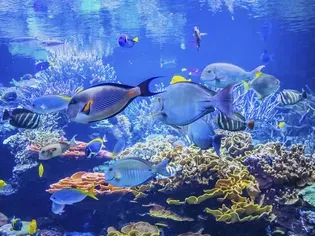Marine Ich, Velvet, or Coral Fish Disease
Updated on 04/26/24

Title: Unraveling the Enigma of Marine Ich, Velvet, and Coral Fish Diseases: A Comprehensive Guide to Diagnosis, Treatment, and Prevention
Introduction:
The captivating underwater realm of marine aquariums is a haven for vibrant corals and exotic fish. However, lurking beneath the beauty lies a sinister threat – infectious diseases that can decimate entire populations in a matter of days. Marine ich, velvet, and coral fish diseases are three of the most prevalent and devastating ailments that plague saltwater aquariums. This comprehensive guide delves deep into the nature, symptoms, diagnosis, treatment, and preventive measures for these dreaded diseases, empowering you to safeguard the health and well-being of your precious marine life.
Section 1: Marine Ich (Cryptocaryon irritans)
Causative Agent and Life Cycle:
Marine ich is caused by a microscopic parasitic protozoan named Cryptocaryon irritans. The life cycle of this parasite consists of three stages:
1. Tomont: The mature parasite attaches to the fish's skin or gills with its mouthparts and extracts nutrients from the host.
2. Theront: After feeding, the tomont releases hundreds of tiny, free-swimming theronts into the water.
3. Tomite: Theronts seek out a new fish host, penetrate the skin or gills, and develop into immature tomonts.
Symptoms:
* White, salt-like spots (1-2 mm) scattered over the body, fins, and gills
* Flashing (rubbing against objects) and rapid breathing due to irritation
* Lethargy and reduced appetite
Diagnosis:
* Microscopic examination of a skin scrape or gill biopsy
* Presence of mature or immature parasites confirms the diagnosis
Treatment:
* Copper-based medications: Copper is toxic to marine ich, but it must be used with caution as it can also harm invertebrates.
* Hyposalinity treatment: Reducing the salinity of the water to 1.008-1.009 can inhibit the development of tomonts.
* Formalin baths: Short-term formalin baths can kill parasites on the fish's body.
Prevention:
* Quarantine new fish for at least four weeks before adding them to the main display.
* Avoid overstocking the tank and provide ample filtration and water flow.
* Maintain optimal water quality (temperature, pH, alkalinity) and perform regular water changes.
Section 2: Velvet (Oodinium ocellatum)
Causative Agent and Life Cycle:
Velvet is caused by a single-celled, dinoflagellate parasite called Oodinium ocellatum. Its life cycle includes two stages:
1. Tomont: The parasitic tomont attaches to the fish's skin or gills and feeds on the host's tissue.
2. Plankton: The mature tomont releases hundreds of tiny, free-swimming plankton into the water.
3. Trophont: Plankton seek out a new host, attach to the skin or gills, and transform into immature tomonts.
Symptoms:
* Velvet-like golden-brown coating on the body, fins, and gills
* Flashing and rubbing against objects
* Rapid breathing and lethargy
* Loss of appetite
Diagnosis:
* Microscopic examination of a skin scrape or gill biopsy
* Presence of mature or immature parasites confirms the diagnosis
Treatment:
* Copper-based medications: Copper is effective against velvet parasites.
* Quinine sulfate: This medication can inhibit the growth and development of parasites.
* Hyposalinity treatment: Reducing salinity to 1.008-1.009 can inhibit parasite development.
Prevention:
* Quarantine new fish for at least four weeks.
* Maintain optimal water quality and provide ample filtration and water flow.
* Avoid overstocking the tank.
Section 3: Coral Fish Diseases
Coral fish diseases encompass a wide range of conditions that affect fish in reef aquariums. Some common examples include:
1. Bacterial Diseases:
* Vibriosis: Also known as "fish tuberculosis," this bacterial infection can cause skin lesions, ulcers, and internal organ damage.
* Mycobacteriosis: This chronic bacterial disease affects internal organs and can lead to emaciation and lethargy.
2. Fungal Diseases:
* Saprolegnia: This fungus causes white or gray fluffy growths on the skin, fins, and gills.
* Achyla: Another fungus that can cause skin lesions and mouth rot.
3. Parasitic Diseases:
* Flukes: These parasitic flatworms attach to the gills or skin and can cause tissue damage and irritation.
* Monogeneans: These external parasites can attach to the gills or body and feed on the host's tissue.
Symptoms of Coral Fish Diseases:
* Skin lesions, ulcers, or white growths
* Rapid breathing or difficulty breathing
* Lethargy and loss of appetite
* Unusual behavior (flashing, rubbing)
Diagnosis:
* Microscopic examination of a skin scrape or gill biopsy
* Clinical examination and observation of symptoms
Treatment:
Treatment for coral fish diseases depends on the specific cause of the infection. Antibiotics, antifungals, or antiparasitics may be prescribed by a veterinarian.
Prevention:
* Quarantine new fish for at least four weeks.
* Maintain optimal water quality and provide ample filtration and water flow.
* Avoid overstocking the tank.
* Feed the fish a nutritious diet to boost their immune system.
Conclusion:
Marine ich, velvet, and coral fish diseases pose a significant threat to the health of marine aquarium inhabitants. By understanding the nature, symptoms, diagnosis, treatment, and preventive measures associated with these diseases, you can effectively safeguard the well-being of your precious marine pets. Remember
Explore More Pets

Freshwater Aquarium Filters
How to Deal With Cloudy Aquarium Water

Saltwater Aquarium Filters
How Do You Remove Chloramines From Tap Water?

Freshwater Aquariums & Habitat
Can I Keep My Koi Fish Inside?

Saltwater Aquariums & Habitat
14 Best Floating Plants for Your Aquarium

Freshwater Fish Health
How to Treat Ich on Freshwater Fish

Saltwater Fish Health
Fin Rot in Aquarium Fish

Freshwater Aquarium Filters
How to Do Aquarium Water Changes

Saltwater Fish Health
How Do Fish Get Parasites?